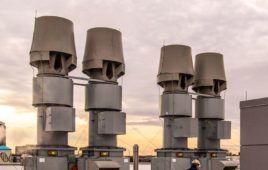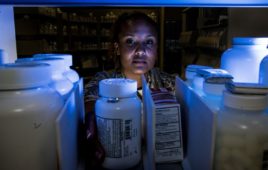Electrostatic charge generation control is required in all cleanroom operations as it can reduce product yield, disrupt automatic equipment from electromagnetic interference (EMI), and reduce surface particle collection by electrostatic attraction (ESA) which is unwanted viable and non-viable particles that may contaminate cleanroom surfaces and product. Semiconductor, microelectronics, aerospace, automotive, and optics cleanrooms are more concerned with the unwanted non-viable particle migration; whereas pharmaceutical, medical device, biopharm, and food industry cleanrooms are more concerned with the unwanted viable particle migration.
Whenever two dissimilar materials are contacted and separated, such as the surface of cleanroom garments when operators are working in the cleanroom, excess electrostatic discharge (triboelectric charge) will be found accumulating on the garments if there isn’t a carbon yarn in the fabric in a grid or stripe pattern to dissipate the accumulating static electricity. This excess charge gives rise to electric fields which can cause unwanted particle migration in the cleanroom. Photosensitized materials and solid state devices may have immediate or latent failures. Drugs or medical devices may be contaminated with airborne microbial contaminants.
As the cleanroom industries have established control measures to maintain the ISO Class 1 to Class 8 cleanroom cleanliness certifications, ESD control measures have evolved in the defense, microelectronics, semiconductor, wafer manufacturing, and disc drive industries. Concurrently, ESA control measures have evolved in the pharmaceutical, medical device, fiber optics, disc drive, and wafer industries.
All cleanrooms are carefully controlled, low relative humidity environments which maintain not only a low particle concentration in the air but also very clean surfaces devoid of any residue on all surfaces. The very clean surfaces and low RH each contribute to high levels of static electricity on all insulating and isolated conducting surfaces. An audit of a cleanroom with an electrostatic field meter will show many surfaces with fields in excess of 5,000 V/in. @ 1 in. This corresponds to a voltage of approximately 5,000 V on the surface.
Such high voltages make surfaces very efficient vacuum cleaners, literally pulling airborne contaminants out of the air and onto the charged surface. If this surface is part of a product being sheltered from contaminants by virtue of being in a cleanroom, the static charge defeats the cleansing action of the cleanroom entirely! A number of measurements have been made in the past about the value of static charge control and they have shown that charged product is typically dirtier by 300 percent to 700 percent (see L.B. Levit et al., “Contamination Control in Semiconductor Manufacturing,” Proceedings of SEMICON Taiwan, Taipei, Taiwan, Sept. 1999.).1 This data indicates that the effect of electrostatic attraction is much greater than the aerodynamic forces caused by laminar air flow in the cleanroom. Electrostatic forces begin to dominate at 1 micron particle size and become increasingly important for smaller particle size. In the future, this effect will become increasingly important as
the minimum size of damaging particles becomes smaller.
The electrostatic forces are greater than one’s intuition would surmise. The product can be moved from its normal location causing the robot to be incapable of lifting the product. Ultimately the process shuts down, possibly with damaged and broken products in the process equipment.
A more subtle effect is that of the transient EMI emission caused by a discharge. Discharges between various objects in the cleanroom are common but when a metal-to-metal discharge of static electricity occurs it is extremely fast, typically only 750 picoseconds long. A discharge of this sort compresses all of the energy into that short of a period of time and results in peak power of hundreds of watts and tens of Amperes (for that short time). Electrical discharges radiate half of the stored energy as an electromagnetic wave. Therefore metal to metal ones radiate a very large impulse for a short time. Such an emission normally causes no effect on the robotic system but occasionally it accidentally is coincident with latching an instruction or a measured value into the processor. Then, the processor tries to execute a meaningless instruction or tries to drive the robot out of its correct path. This ends up looking like either an unintelligible error message and a halted process tool or a product which is destroyed by a bogus movement of the robotic arm. The effect is rare so that it might occur once in a few days and such an effect is difficult to track down without sophisticated high speed electronics to identify the culprit.
To deal with these issues, it is necessary to do routine static audits with an electrostatic field meter looking for large electric fields which arise from static charge. In some applications, it is practical to remove one or two products from the line with a robot and move them into a Faraday Cup to directly measure the charge on the product. Also, using a very fast digitizing oscilloscope with an antenna tuned to pick up the sub-nanosecond discharges can locate issues within the cleanroom. To deal with these issues:
1. Ground all conductors wherever possible.
2. Eliminate non-essential insulators wherever possible.
3. Select materials for the handling process which are well matched electrically to the product being handled.
4. Install air ionizers wherever it is not possible to follow rules 1, 2, and 3 above.
Conclusion
Contamination control measures will continue to improve. However, it may be impossible to completely maintain a totally contamination-free environment, even in mini-environments and barrier isolators. Therefore, an overall contamination control program should evaluate all sources of contamination including static charge. Eliminating static charge in the cleanroom industries produces benefits of improved quality and yield, higher throughput, and lower costs for equipment maintenance and rework, therefore yielding higher profits.
References
1. L.B. Levit et al. Contamination Control in Semiconductor Manufacturing. Proceedings of SEMICON Taiwan, Taipei, Taiwan. Sept. 1999
Jan Eudy is a cleanroom and contamination control consultant with Jan E. Eudy Consulting. She is also a Fellow and President Emeritus of the Institute for Environmental Sciences and Technology. Jan can be reached at [email protected].
Larry B. Levit, Ph.D, an experimental physicist by training, has been consulting on electrostatic issues in high technology manufacturing for nearly 20 years. He has been in a wide variety of cleanrooms on three continents and worked with many clean environments, solving specific problems and setting up static control programs for many customers. One of his unique skills is in locating and eliminating ultra-fast discharges using an oscilloscope and an antenna, thus finding the source of bad robot behavior and fixing it. He is available to solve electrostatic problems in a variety of environments. www.LBLScientific.com
This article appeared in the September/October 2015 issue of Controlled Environments.



